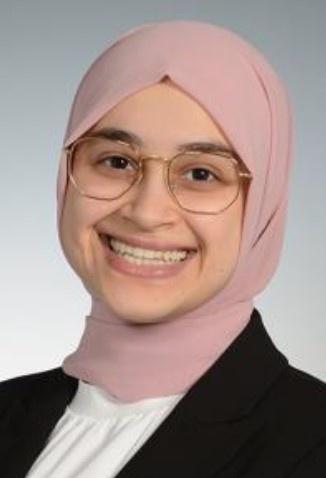
Tasnim Mushannen, MD, first found her passion for neuroscience in middle school, when she wrote a hand-written, 10-page paper on the brain and nervous system. This passion, combined with a desire to connect with her patients, led her to pursue a career in neurology, and she is now finishing her first internal medicine year of her residency at the Duke University School of Medicine. For this week’s “Spotlight” interview, Mushannen talks about the most memorable experiences of her residency so far, her research on post-stroke seizures, and enjoying board games, exploring coffee shops, and time with family when she’s not at Duke.
What are your current responsibilities as an internal medicine resident? What does a typical workday look like for you?
Being an internal medicine resident has been great! My responsibilities include performing histories and physical exams, coming up with plans for patients, and ordering the necessary diagnostic testing and medications. I am also responsible for consulting the specialty services that the patient might need, being first-call for my patients and responding to pages, updating patients’ family members if the patient would like that, and writing a daily progress note for each patient.
My typical workday starts at 7:00 a.m. when I get sign-out from the resident covering my patients’ overnight. Then, from 7:00 - 8 a.m., I review each patient's chart, specifically looking at their vital signs, morning lab results, any new results on imaging/cultures/pathology, and any new notes written by consulting services and nurses. From 8:00 – 11:00 a.m. I round on my patients with the attending and upper-level resident. This is my favorite part of the day because I get to see my patients! One of my favorite things about Duke is that the attendings and upper-level residents allow the interns to lead the patient encounters during rounds.
After rounds, we go back to our workroom, and we take 15 – 30 minutes to finalize each patient’s plan. Then, from 11:30 a.m. – 12:00 p.m., I place consults and orders, respond to pages, and write my daily progress notes. From 12:00 – 1:00, I attend noon conference. After our noon conference, I take new admissions and continue any remaining work from before the noon conference. At 7:00 p.m., I sign-out my patients to the overnight covering resident, and then I go home.
How and when did you first get interested in neurology? What specialties or aspects of the field excite you the most?
I first became interested in neurology in middle school through an assignment called “The Big Brain Paper.” It was a hand-written, 10-page paper of the basic neuroscience concepts we had learned during the semester. Since then, I always found myself gravitating towards neuroscience topics. I chose to pursue a career in neurology because it was the specialty that made me feel most connected to my patients. Seeing the impact that neurologic conditions can have on a person’s quality of life and wellbeing made me want nothing more than to treat these conditions.
What’s one aspect or experience from your PGY-1 year so far that’s been especially memorable or helpful?
Every experience has been so memorable! If I had to choose one, it would be the cardiac/respiratory arrest simulations on Wednesday mornings in the VA ACC (VA emergency department). I really appreciated all of the practice I got, and I feel more comfortable running a code blue if I ever have to in the future.
Last year you contributed to a Frontiers in Neurology article examining the effects of reperfusion therapies on early stroke seizures. What were the main findings of that work, and how will they help us better understand or treat stroke patients?
The main findings were that patients with ischemic strokes who received reperfusion therapy (thrombectomy, thrombolysis, or both) were not at increased risk of developing early post-stroke seizures (PSS) compared to those who did not receive reperfusion therapy. This is important because preclinical studies show that tissue plasminogen activator (tPA) has pro-convulsive effects and because the existing clinical literature varies; there are studies that show increased risk, decreased risk, and no significant difference in risk of early PSS based on whether patients receive reperfusion therapy or not.
This study had a larger sample size than most of the published studies, and the patients were matched for NIHSS score, age, and gender. We also determined significant risk factors for developing early PSS after ischemic and hemorrhagic strokes. This helps clinicians know for which patients they should have a low threshold to consider an early PSS in if the patient’s clinical status changes.
What do you enjoy most about being a resident?
Getting to take care of people and getting to work with kind, passionate, and fun colleagues! I also love that no effort ever goes to waste, and there is always more that I can do for my patients. It is truly one of the most rewarding jobs.
What’s the hardest part of residency so far?
Finding time to do all of the things I would love to do. But I have definitely had time to do the things at the top of my list!
What other passions or hobbies do you have outside of the Department?
I enjoy spending time with family and friends, running, playing board games, exploring new coffee shops, and going on long walks!
